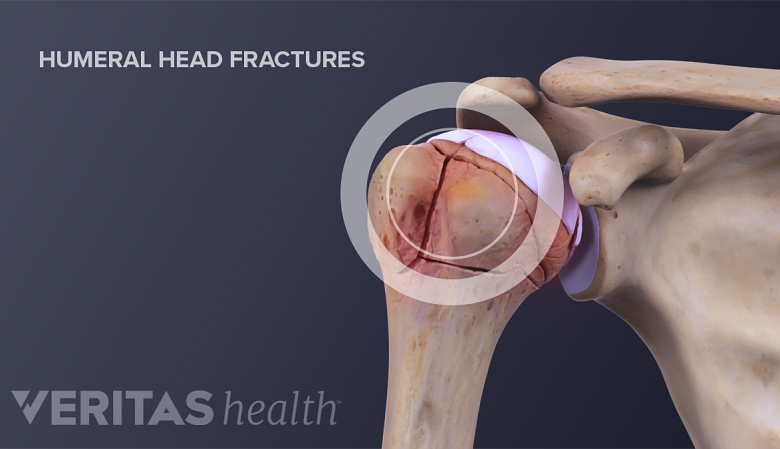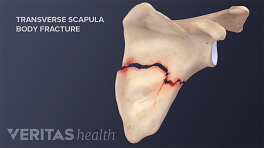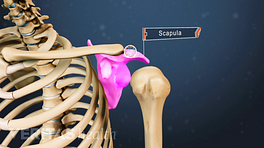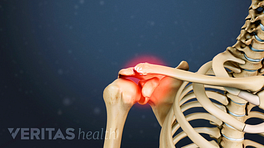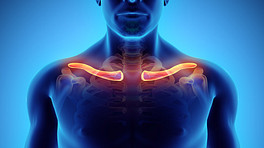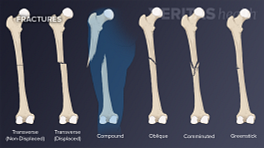A proximal humeral fracture refers to a break involving the area surrounding the humeral head, which is commonly known as the ball of the shoulder’s ball-and-socket joint. The humeral head is located at the top of the humerus (upper arm bone). A proximal humerus fracture can greatly affect the shoulder joint and upper arm movement.
A shoulder fracture can occur in the proximal head of the humerus (upper arm bone).
In This Article:
- Proximal Humerus Fractures of the Shoulder
- Treating a Proximal Humerus Fracture
A proximal humeral fracture can cause pain, swelling, and bruising of the upper arm all the way down to the elbow. Other symptoms may include:
- Limited shoulder motion.
- Numbness in the affected arm or hand.
- Upper arm deformity.
Proximal humeral fractures are a common type of fracture, most frequently seen in the elderly population. Experts estimate there are between 105 and 342 proximal humeral fractures per 100,000 people each year. 1 Burkhart KJ, Dietz SO, Bastian L, Thelen U, Hoffmann R, Müller LP. The treatment of proximal humeral fracture in adults. Dtsch Arztebl Int. 2013;110(35-36):591-7.
Who Is at Risk for a Proximal Humeral Fracture?
Younger people involved in high-impact sports or high-energy accidents may sustain a proximal humeral fracture. 1 Burkhart KJ, Dietz SO, Bastian L, Thelen U, Hoffmann R, Müller LP. The treatment of proximal humeral fracture in adults. Dtsch Arztebl Int. 2013;110(35-36):591-7. These fractures can occur during contact sports, such as football, gymnastics, and cycling; motor vehicle accidents; and falls while horseback riding. They occur less frequently in athletes playing non-contact sports, such as baseball. Intense muscle contractions—due to seizure or electric shock—are another cause of proximal humerus fractures and dislocations in the younger population.
Proximal humeral fractures are most commonly seen in older people because of poor bone density (osteopenia or osteoporosis) and may occur due to a low-impact fall such as falling onto an outstretched hand. 2 Chu SP, Kelsey JL, Keegan TH, Sternfeld B, Prill M, Quesenberry CP, Sidney S. Risk Factors for Proximal Humerus Fracture. American Journal of Epidemiology. 2004; 160: 360-367. These fractures are the third most common type of fracture seen in patients over the age of 65, 3 Baron JA, Barrett JA, Karagas MR. The epidemiology of peripheral fractures. Bone. 1996 Mar;18(3)(Suppl):209S-13S. and more frequently seen in women. 4 Kristiansen B, Barfod G, Bredesen J, Erin-Madsen J, Grum B, Horsnaes MW, Aalberg JR. Epidemiology of proximal humeral fractures. Acta Orthop Scand. 1987;58:75-7.
- 1 Burkhart KJ, Dietz SO, Bastian L, Thelen U, Hoffmann R, Müller LP. The treatment of proximal humeral fracture in adults. Dtsch Arztebl Int. 2013;110(35-36):591-7.
- 2 Chu SP, Kelsey JL, Keegan TH, Sternfeld B, Prill M, Quesenberry CP, Sidney S. Risk Factors for Proximal Humerus Fracture. American Journal of Epidemiology. 2004; 160: 360-367.
- 3 Baron JA, Barrett JA, Karagas MR. The epidemiology of peripheral fractures. Bone. 1996 Mar;18(3)(Suppl):209S-13S.
- 4 Kristiansen B, Barfod G, Bredesen J, Erin-Madsen J, Grum B, Horsnaes MW, Aalberg JR. Epidemiology of proximal humeral fractures. Acta Orthop Scand. 1987;58:75-7.
